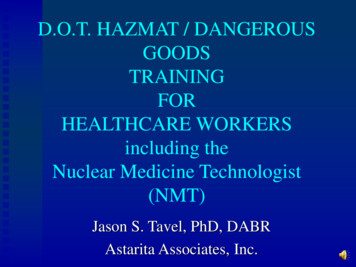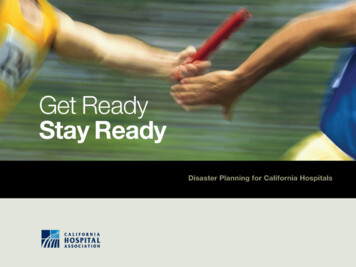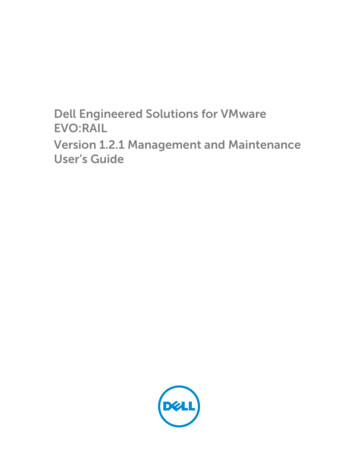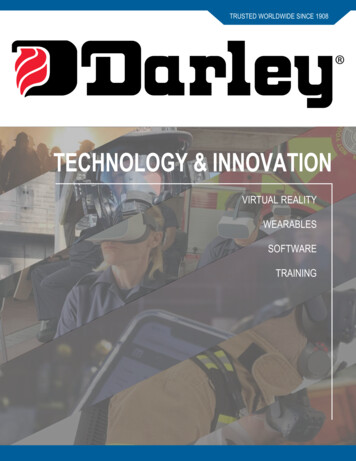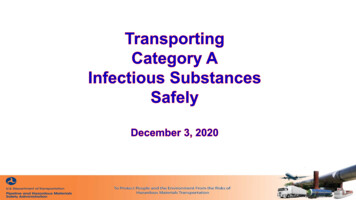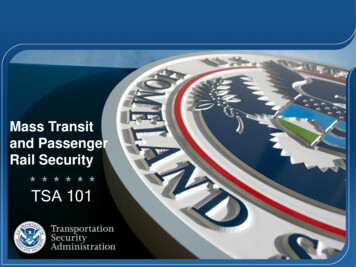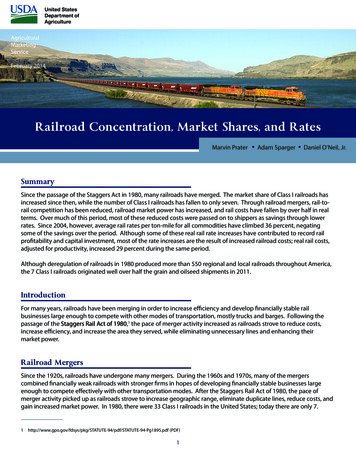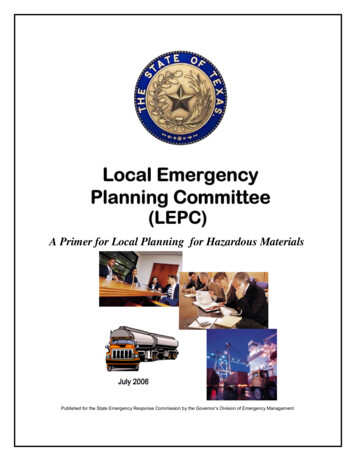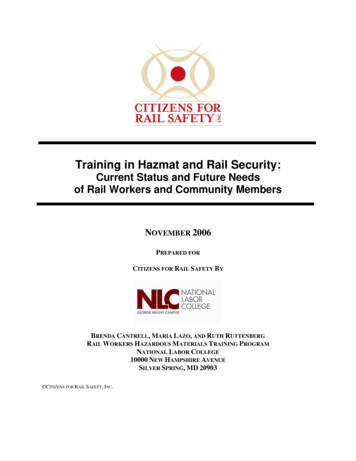
Transcription
Training in Hazmat and Rail Security:Current Status and Future Needsof Rail Workers and Community MembersNOVEMBER 2006PREPARED FORCITIZENS FOR RAIL SAFETY BYBRENDA CANTRELL, MARIA LAZO, AND RUTH RUTTENBERGRAIL WORKERS HAZARDOUS MATERIALS TRAINING PROGRAMNATIONAL LABOR COLLEGE10000 NEW HAMPSHIRE AVENUESILVER SPRING, MD 20903 CITIZENS FOR RAIL SAFETY, INC.
TRAINING IN HAZMAT AND RAIL SECURITY:CURRENT STATUS AND FUTURE NEEDS OF RAIL WORKERSAND COMMUNITY MEMBERSEXECUTIVE SUMMARYIn-depth quality training for rail workers and community members is essential for saving livesand health. It is currently inadequate. Just one 90-ton rail car of chlorine, whether involved in anaccident or act of terrorism, could create a toxic cloud 40 miles long and 10 miles wide and couldkill as many as 100,000 people in 30 minutes. One estimate of a worst case scenario for a nucleartransportation accident in an urban area could cost --- in cleanup, evacuation, and business loss –from several billion to several tens of billions of dollars.Railroads in the United States transport 1.8 million shipments of hazardous materials every year,using 100,000 tank cars, filled with such chemicals as chlorine, anhydrous ammonia, cyanidecompounds, flammable liquids and pesticides. The result is one million tons of hazardousmaterial being moving across the nation daily. Every day tank cars filled with hazardousmaterials travel by homes, schools, and hospitals, and through the middle of cities and alonghighways.Between 1988 and 2003 there were 181 acts of terror, worldwide, involving railroads and relatedrail targets. Security experts and government officials, as well as chemical and rail tradeassociations, acknowledge the vulnerability of railcars, bridges, and tunnels to intentional acts ofterror. The risk of death and serious illness from unintentional accidents involving hazardousmaterials is also high. Though the vast majority, 99.98 percent according to the railroads, ofHazmat shipments arrive safely and without major incident, there are fatalities, hospitalizations,and/or evacuations every year from the escape of a large quantity of gases or liquids.Quality training for rail workers, emergency responders, and residents of rail communities –including joint training exercises – is one necessary part of an overall safety and security actionplan. Changes also need to be made in rail equipment and operations to make Hazmat transportsafer.I.Key FindingsI.A.Training Rail workers are poorly trained in recognizing and responding to Hazmats. Railroadtraining focuses on rules and operations, not preparedness and first on the scene response. The typical emergency responders are poorly trained in responding to Hazmat incidents,especially involving rail, and usually have little knowledge of the rail infrastructure intheir communities or the chemicals moving through by rail. Citizens in “rail communities” generally know little about the Hazmats moving throughtheir towns and do not know what to do should there be an emergency. Rail HazmatsEXECUTIVE SUMMARYP.i
often run through densely populated areas. There are few forums that bring together rail workers, emergency responders, andcitizens to learn about and plan for rail Hazmat incidents. There are very few jointtraining exercises. Many communities are without emergency action plans for rail emergencies. Hazmat safety and health training saves lives. Trainees learn to go upwind, to usebinoculars rather than approach a leaking tank car, to call for professional Hazmatassistance, to use resources to determine such life saving information as isolationdistance. In two recent and fatal rail Hazmat accidents, more and better training couldhave saved lives. In Graniteville, South Carolina in 2005 a conductor lived because hismilitary training taught him not to run, but to walk out of a cloud of chemical gas.Chlorine killed his engineer partner, who without training, ran and because of his deepinhalation of chlorine gas, ran to his death. Also, in Graniteville, residents did notgenerally know that the gas cloud that threatened them was heavier than air and that theirsafest escape was not only upwind, but also uphill. In Bexar County, Texas, in 2004,three people -- a trainman and two community residents -- died as a result of a majorchlorine leak following a derailment. If emergency dispatchers knew the dangers of railHazmat and the lethal nature of chemical releases, appropriate advice and a properresponse to the 911 calls might have saved those residents. Instead they heard the wordsmoke and difficulty breathing and sent firefighters to an assumed medical emergency. A well-trained and knowledgeable workforce is the first line of defense to keep a minorevent from becoming a major hazardous materials incident. In most rail emergencies, railworkers are first on the scene. Joint training exercises with community emergencyresponders, as well as annual refresher training for rail workers and responders alike, isimportant. Rail workers need security training, and according to research by the InternationalBrotherhood of Teamsters and the Railroad Workers Hazardous Materials TrainingProgram, 80 percent of workers have not received any security training beyond being toldto be vigilant and report anything suspicious.I.B.Security Rail cars, tracks, yards, and basic infrastructure are not sufficiently secure. They are notonly poorly protected from possible terrorists, but often in poor maintenance, makingthem more vulnerable to accidents. Rail Hazmat cars are extremely vulnerable when they sit for hours and even days andweeks, unattended and unsecured, along track sidings and in yards.EXECUTIVE SUMMARYP.ii
I.C.Radioactive Shipments Over the next decade the amount of radioactive waste to be transported by rail will growsubstantially, and there must be training of affected individuals and development ofemergency action plans along affected train routes.II.Key Recommendations (from among more than 100)II.A.TRAINING!For Workers Address the critical need for Hazmat training – awareness, preparedness, prevention, andemergency response – for rail workers. Organize and stage rigorous joint training andexercises with fire, police, dispatchers, and emergency medical personnel at hospitals.Develop minimum criteria for quality rail Hazmat courses that include hands-on smallgroup exercises led by fully trained peer trainers. All rail workers need to be an integralpart of team briefings. A well-trained and knowledgeable workforce is the first line ofdefense to keep a minor incident from becoming a major hazardous materials incident. Achieve buy-in for Hazmat and rail security training by all Class I, short-line, andpassenger railroads. Require rail carriers to develop a rail worker training program and totrain all of their rail workers within one year.For Emergency Responders and Community Residents Provide rail Hazmat awareness training for emergency responders (including police) andresidents of rail communities – not just about Hazmat in rail transportation, but also aboutthe roles of evacuation vs. shelter-in-place and the importance of wind direction andelevation. Training needs to include specific knowledge of what Hazmats are transported throughones community. Railroads should provide regular information on what hazardousmaterials are moving by rail through their communities. Communities need to develop and implement emergency action plans, and then providetraining on the plans so everyone knows what to do if there is an emergency. 911 centers should develop a checklist with standard operating procedures. Assemble a committee of citizens and associated organizations to assert their right-toknow about existing risks.For Health Care Professionals and Emergency Dispatchers Provide specialized training for health care professionals, who will be “first receivers” inthe event of an emergency. Ensure that emergency medical service and hospitalemergency department staffs have the necessary guidance to plan for, and improve theirability to respond to, incidents that involve human exposure to hazardous materials.EXECUTIVE SUMMARYP.iii
Provide rail Hazmat awareness training to all emergency dispatchers.II.B.Need for Railroads to Improve Equipment and Operating Procedures Adopt operating procedures to enhance the safety and health of everyone – in dailyactivities as well as in the event of a Hazmat incident. Upgrade and secure cars and infrastructure – yards, tracks, bridges, and tunnels -- againstthe threats of Hazmat incidents, whether accidental or pre-meditated. Minimize the use of cars for chemical storage. Replace cars in poor condition. Where possible re-route Hazmat shipments to avoid rail transport through majorpopulation centers. Do not allow trains to leave terminals without proper paperwork. Hire more railroad police.II.C.Government Needs to Be More Involved Make issues related to Hazmat and security training a more visible part of the work ofrelevant federal agencies, like the National Transportation Safety Board, Federal RailroadAdministration, and the Department of Homeland Security. Pass legislation to upgrade and mandate in-depth, quality training for rail workers,emergency response personnel, and the community. Penalize rail corporations who fail to adequately train. Require the railroads to regularly inform officials of the 25 main Hazmats going throughor adjacent to their communities. Dedicate and increase funding for rail and mass transit security. Enforce Superfund and state clean-up for designated rail yards. Promote research in epidemiology and toxicology to better document the relationshipbetween exposure to Hazmats and disease. Require a comprehensive medical surveillance program for all rail workers and contractemployees.III.Summary and ConclusionsMillions of lives and billions of dollars are at stake in efforts to improve rail safety and security.Quality training is key. Hands-on, small group exercises led by highly qualified peer trainers –supplemented by simulations, audio visuals, and group discussion – need to reach all who mayEXECUTIVE SUMMARYP.iv
be affected. Short videos and tests on rules are insufficient. Education and training need tocover first response, familiarity with local emergency action plans, hazard identification, healtheffects, and how to use resources. Partnerships among rail companies, rail unions, federallegislators and regulators, state and local emergency responders, and community residents are inthe best interest of all parties.EXECUTIVE SUMMARYP.v
CURRENT STATUS AND FUTURE NEEDS OF RAIL WORKERSAND COMMUNITY MEMBERSCITIZENS FOR RAIL SAFETYTABLE OF CONTENTSExecutive SummaryIntroduction: An Urgent Need for Improvements in Hazmat and Security Training . 1The Problem. 1The Importance of Training. 4I.Safety and Security Problems for the Nation’s Railroads, Its Workers,and the Communities Along Rail Routes . 7I.A.I.B.I.C.I.D.I.E.I.F.Examples of Recent Rail Hazmat Incidents.10Use of Rail Cars to Store Hazmats .13Rail Cars in Poor Condition.16Rail Hazmat Shipments Traveling Through Populatedand Strategic Areas .18Potential Impact of a Rail Accident Involving Spent Nuclear Fueland/or Highly Contaminated Radioactive Waste.20Poor Security.22II. The High Economic Cost of Hazmat Incidents .23III. Role for Training .26III.A. Description of Existing Hazmat Training for Rail Workers.29III.A.1. Training by the Railroads.29III.A.2. Other Providers of Hazmat Training for Rail Workers.32III.B. Description and Assessment of Existing Hazmat Trainingfor Emergency Responders .34III.B.1. Examples from Current Prevention and Response Training.36III.B.2. Programs Supported by the Department of Homeland Security (DHS) .38III.C. Description of Existing Hazmat Training for Community Residents.39III.C.1. The Community’s Need to Know .41III.C.2. Local Emergency Planning Committees .42TABLE OF CONTENTSP.1
III.D. Training Materials.44III.D.1. Training Materials for Rail Workers.45III.D.2. Training Materials for Emergency Responders .46III.D.3. Training Materials for Members of the Community.46III.E. Specific Examples of Where Training Could Have Made a Difference.47III.F. General Principles for Training Excellence.49IV. Recommendations.52IV.A. Improve and Expand Training .52For Rail Workers .52For Emergency Responders .54For Government .55For Community Residents .55IV.B. Better Access to Information .56IV.C. Minimize the Use of Cars for Storage .56IV.D. Eliminate Cars in Poor Condition .57IV.E. Improve Community Awareness and Action.57IV.F. Need for Data Analysis.58IV.G. Improve Emergency Response .59IV.H. More Use of Engineering Controls .59IV.I.Improve Maintenance and Operations .60IV.J.Build Partnerships.60IV.K. Proper Access and Use of Personal Protective Equipment.61IV.L. More Planning.61IV.M. Policy Initiatives and Actions .63IV.N. Rerouting Where Feasible.64IV.O. Improve Security, Surveillance, and Vigilance .64IV.P. Make Yards and Stations Safer.65TABLE OF CONTENTSP.2
IV.Q. Other .65V.Summary and Conclusions .66BibliographyTablesTable 1:Most Common Hazardous Substances Released During Rail Events,Hazardous Substances Emergency Events Surveillance (HSEES) System,16 States, 1999-2004Table 2:Average Cost Per Hazmat Incident By Transportation ModeTable 3:Hazmat Summary by Mode of Transportation / Cause for 2005, SeriousIncidentsAppendicesAppendix 1:“Community Workbook”Appendix 2:General Findings and RecommendationsAppendix 3:Specific Findings and RecommendationsTABLE OF CONTENTSP.3
TRAINING IN HAZMAT AND RAIL SECURITY:CURRENT STATUS AND FUTURE NEEDS OF RAIL WORKERSAND COMMUNITY MEMBERSCITIZENS FOR RAIL SAFETYSEPTEMBER 2006Introduction:An Urgent Need for Improvements in Hazmat and SecurityTrainingAn accident or act of terrorism, in a densely populated area, involving justone 90-ton rail car of chlorine, with a targeted explosive device, couldcreate a toxic cloud 40 miles long and 10 miles wide and could kill asmany as 100,000 people in 30 minutes. 1The ProblemRailroads in the United States transport 1.8 million shipments of hazardous materialsevery year, 2 using 100,000 tank cars, 3 filled with such chemicals as chlorine, anhydrousammonia, cyanide compounds, flammable liquids and pesticides. The result is onemillion tons of hazardous material being transported across the nation daily. 4 After coal,chemicals and allied products have the highest tonnage -- nearly 170 million tons in 20041J. Boris, Naval Research Laboratory, “Results of a Large Urban Release,” Testimony to Washington,D.C. City Council, October 6, 2003.2Association of American Railroads, Policy and Economics Department, “Hazmat Transport:Mandatory Rerouting and Pre-Notification,” January 2006, http://www.aar.org, retrieved July 2006.3Association of American Railroads, Railroad Facts, 2003 Edition; Association of American Railroads,Policy and Economics Department, “Railroad’s: The Safe Way to Move,” January 2006; Associationof American Railroads, “Hazmat Transport ,” January 2006; David Kocieniewski, “Despite 9/11Effect, Railyards are Still Vulnerable,” New York Times, March 27, 2006.4Hon. Elijah Cummings, “There is a better – and safer – way to run the nation’s railroads,” The HillNewspaper, September 4, 2002.TRAINING IN HAZMAT AND RAIL SECURITY: CURRENT STATUS AND FUTURE NEEDSP. 1
-- of all the types of freight carried by rail.5 More than 64 percent of chemicals that aretoxic when inhaled are currently transported by rail.6 BNSF alone transports: 7 Enough propane each year to fill more than 100 million five-gallon propane tanksEnough lube oil to fill 1.6 billion quarts of motor oilEnough petroleum wax to produce 100 million fire logsEnough asphalt to lay a single lane road four times around the equator.Every day tank cars filled with hazardous materials travel past homes, schools, andhospitals, through the middle of cities, and along highways.Besides the potential for huge loss of life, there is also the risk of, literally, billions ofdollars of burden to individuals, the communities, businesses, and general economy ofthe country. One expert study 8 estimated that a worst case scenario for a nucleartransportation accident in an urban area could cost --- in cleanup, evacuation, andbusiness loss –from several billion to several hundred billion dollars. Well over 100,000people could be downwind and contaminated. Using four scenarios, the authorscalculated that with a severe spent fuel truck accident in Las Vegas, the decontaminationcosts would range from 2 billion to 28 billion, but the same category accident by railwould yield decontamination costs of 15 billion to 190 billion.5Association of American Railroads, Policy & Economics Department, “Class I Railroad Statistics,January 13, 2006. There are 7 Class I U.S. railroads: BNSF Railway (BNSF), CSX Transportation(CSX), Grand Trunk Corporation, Kansas City Southern Railway, Norfolk Southern CombinedRailroad Subsidiaries (NS), Soo Line Railroad, and Union Pacific Railroads (UP) as well as regional,local, and switching and terminal railroads. The seven Class I U.S. railroads account for 93 percent ofthe industry’s total revenue. There are 31 regional and over 500 local (shortline or switching andterminal) railroads. There are approximately 175,000 rail workers across the United States. Each ofthe Class I railroads has operating revenue in excess of 289.4 million. Two Canadian railroads haveenough revenue that if they were U.S. companies, would be U.S. Class I railroads: Canadian NationalRailway and Canadian Pacific Railway. Both own railroads in the U.S. that by themselves qualify tobe Class I railroads. Two Mexican railroads would also be Class I if they were U.S. railroads:Ferrocarril Mexicano and Kansas City Southern de Mexico.6Kip Hawley, Assistant Secretary, Department of Homeland Security in Congressional testimony, citedin Judy Thomas, “One-man train crew plan raises security fears,” McClatchy Newspapers, June 2006.7BNSF Railway, “BNSF Facts,” http://www.bnsf.com/media/bnsffacts.html, retrieved July 7, 2006.8Matthew Lamb, Marvin Resnikoff, and Richard Moore, “Worst Case Credible Nuclear TransportationAccidents: Analysis for Urban and Rural Nevada,” Radioactive Waste Management Associates, NewYork City, August 2001, , retrieved June 2006.TRAINING IN HAZMAT AND RAIL SECURITY: CURRENT STATUS AND FUTURE NEEDSP. 2
Another study, for the State of Nevada, 9 found that under the conditions of the BaltimoreTunnel fire in 2001 (see discussion later in this paper), had there been a release ofradionuclides from a single rail cask, the accident could contaminate three square miles.Failure to adequately clean up the contamination would cost 13.7 billion and wouldcause 4,000 to 28,000 cancer deaths over the following 50 years. Between 200 and 1,400cancer fatalities would be expected during the first year. While spent fuel casks are verystrong, and designed to withstand a 1475 F. fire for 30 minutes, the Baltimore Tunnelburned for several days at temperatures that exceeded 1500 F.One would think that with such risks to life, health, and the economy, that rail securityand hazardous materials (Hazmat) safety would be a national priority, especially post 911. Unfortunately, this does not seem to be the case. No national planning to make railoperations more secure has occurred. Ninety percent, or 4.6 billion in FY05, of theTransportation Security Administration’s (TSA in the Department of Homeland Security)budget is for aviation security. What is left is just 32 million for truck, bus, port,pipeline, transit, and rail together. According to one security expert, “Rail security is offtrack.” 10The potential for deadly accidents, natural disasters, and man-made acts of terrorinvolving railroads is high across the nation. There are also risks from leaks and spills,and contamination of soil, water, and air from everyday activities of the nation’srailroads. Among the many necessary activities to safeguard workers, emergencyresponders, and communities is training – training for disaster response and training tosafeguard against Hazmat incidents.The purpose of this paper is to explore the current status of training about hazardousmaterials and rail security -- for railroad employees, emergency responders, and citizensof rail communities -- and to identify future training needs and make recommendations.The paper explores the nature of Hazmat and security training, along with descriptions ofmodel programs and their results. Responses of rail workers, emergency responders, andcitizens about their perceived needs for training, the power of training when they receiveit, and their assessment of future training needs is also shared. Because of the focus onhazardous materials and security, this study mainly addresses the nation’s freightrailroads.9M. Lamb and M. Resnikoff, “Radiological Consequences of Severe Rail Accident Involving SpentNuclear Fuel Shipments to Yucca Mountain. Hypothetical Baltimore Rail Tunnel Involving SNF,”Radioactive Waste Management Associates, September 2001 in Marvin Resnikoff, “Testimony byMarvin Resnikoff, Joint Hearing on Transportation of Spent Rods to the Proposed Yucca MountainStorage Facility, U.S. House of Representatives, Committee on Transportation and Infrastructure,Subcommittee on Railroads, April 25, 2002.10Fred Millar, “New Strategies to Protect America: Putting Rail Security on the Right Track,” CriticalInfrastructure Security Series, Center for American Progress, http://www.americanprogress.org/atf/cf., retrieved July 2006.TRAINING IN HAZMAT AND RAIL SECURITY: CURRENT STATUS AND FUTURE NEEDSP. 3
The Importance of TrainingSafety and health training saves lives. The outcomes of training have been documentedthrough the experiences of the Worker Education and Training Program (WETP) of theNational Institute of Environmental Health Sciences (NIEHS), which has supportedtraining for over a million workers since 1987. 11 Training makes a difference, and lackof training can be deadly. In Graniteville, South Carolina, in 2005, for example, trainingof the railroad operating personnel, local citizens, and factory workers could have savedlives. According to one rail safety expert: “Graniteville, S.C. I assisted in investigatingthe derailment as part of the BLET 12 -safety task force. I feel if the train crew involvedwas better versed on Hazmat exposure, a fatality would not have occurred.”There are multiple examples where training did or could have made a difference inGraniteville. Saving the life of the railroad conductor: The railroad engineer ran out of thepoisonous chlorine; his deep breathing intensified his exposure and he wasovercome. The conductor, on the other hand, had received training in the militaryand knew, that in the case of poison gas, one should walk calmly out of the plumeand breathe as shallowly as possible. The conductor survived. 13 Saving lives of residents living close to the derailment:o “. a former chemistry teacher, saw a green cloud boiling up the gorge towardPowell Street and shouted at his neighbors to get inside. ‘Get in the house!’he yelled. ‘Turn off your ventilation!’ He knew chlorine when he saw it, andhe was quick to follow his own advice.” 14o The Graniteville derailment included three cars carrying 90 tons each ofdeadly chlorine gas. Sixty tons of chlorine went into the night air andinstantly vaporized. 15 Many victims were overcome when they ran down hill11National Clearinghouse of Workers Safety and Health Training for Hazardous Waste Workers andEmergency Responders, for U.S. Department of Health and Human Services, National Institutes ofHealth, National Institute of Environmental Health Sciences, “Minimum Health and Safety TrainingCriteria: Guidance for Hazardous Waste Operations and Emergency Response (HAZWOPER),HAZWOPER-Supporting and All-Hazards Disaster Prevention, Preparedness, and Response,” May2005.12Brotherhood of Locomotive Engineers and Trainmen13Interview with Mr. Brian McLaughlin, Brotherhood of Locomotive Engineers and Trainmen, LocalChair, Division 85, Columbia, South Carolina.14N.J. Nidifer, Un-Natural Disaster: Stories of Survival After Graniteville Tragedy, Harbor House,Augusta, Georgia, 2005.15Nidifer, 2005.TRAINING IN HAZMAT AND RAIL SECURITY: CURRENT STATUS AND FUTURE NEEDSP. 4
into the chlorine poison. Being able to identify chlorine and learning thatchlorine is heavier than air might have saved ones life or health.In Bexar County, Texas in 2004, lives might have been saved if emergency dispatchershad received Hazmat awareness training. A Union Pacific train struck a BurlingtonNorthern train, resulting in the derailment of four locomotives and 35 rail cars. A 90-tonchlorine car was breached and released tons of chlorine. There were also releases ofnitrogen fertilizer and diesel fuel, and a fire resulted from some of the spilled fuel. Threepeople died, one rail worker and two community residents. Forty-three people weretransported to hospitals. Training of emergency dispatchers might have saved lives; itcould have prevented injuries. If the lethal nature of a release had been known or evensuspected, the calls for help from those who subsequently died, might have been betterhandled – in both terms of dispatching emergency response and also the instructionswhich dispatchers could have given to the distressed callers. According to aninvestigative report by the Environmental Protection Agency (EPA), 911 dispatchers onlypicked up on the words “smoke” and “difficulty breathing,” even though “various callersto 911 mentioned ‘train derailment’ or ‘train wreck.’” Volunteer firefighters initiallyresponded to a ‘medical emergency’ based on 911 information. They were not aware ofthe train derailment and the major emergency until they arrived on the scene. Keyinformation collected early on by entities operating under mutual aid agreements wasdisregarded or not readily acted upon. Because the engineer and conductor were injured,the manifest was not available and the cargo and released material could not be easilyidentified. Some residents were told to evacuate and others to shelter-in-place. Thosewho were told to shelter-in-place were not adequately instructed in how to do thatsafely. 16 EPA had many recommendations for needed training and future actions. (SeeRecommendations section of this paper for some of them.)Sometimes a Hazmat incident is an accidental derailment, with Hazmat releases killingrail workers and citizens alike. Also, of great concern is the possibility of a premeditated, terrorist atta
Training in Hazmat and Rail Security: Current Status and Future Needs of Rail Workers and Community Members NOVEMBER 2006 PREPARED FOR CITIZENS FOR RAIL SAFETY BY BRENDA CANTR LLE, MARIA LAZO, AND RUTH RUTTENBERG RAIL WORKERS HAZARDOUS MATERIALS TRAINING PROGRAM NATIONAL LABOR COLLEGE 10000 NEW HAMPSHIRE AVENUE SILVER SPRING, MD 20903 CITIZENS FOR RAIL SAFETY, INC.
